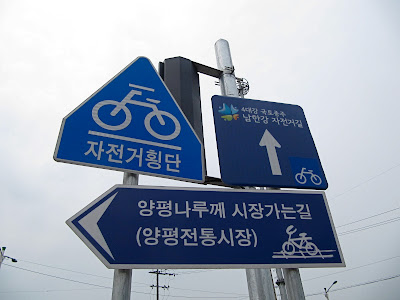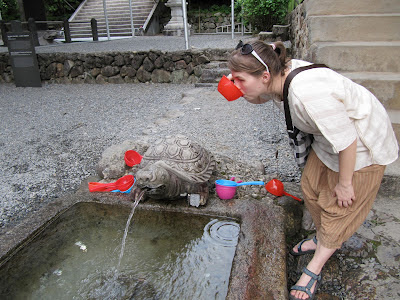With the Buddha's Birthday holiday weekend fast approaching, we had to think of something exciting to do. We finally settled on a trip from Yangsuri to Chungju. We calculated the trip to be approximately 110km. We had done 60 km without too much trouble from Yangsuri to our house in Seoul and figured, another 50 km wouldn't be so bad.
We set off from Yangsu station, about an hour outside of Seoul on the Jungang line, at 10 am. A later start than we had hoped for, but it was the best we could do given that the Jungang line only runs every half an hour or so as far as Yangsuri and we wanted to eat breakfast before hitting the road.
From Yangsuri to Yangpyeong, it's about 15 km, or about an hour ride. The scenery is fantastic here, at certain points you literally ride your bike through rice paddies as you can see above. This is my second time on this course and it just gets lovelier each time. You kind of get the feeling sometimes that you're no longer in Seoul, but in Southeast Asia. It's easy to forget that Korea is not all apartment complexes and cell phone stores when you're living in a city.
After arriving in Yangpyeong around 11 am, we were starting to feel a little depressed when we saw the sign for Chungju Dam, 96km. But, we continued on bravely, following the signs for the Namhangang bicycle path and for Chungju Dam.
The path after Yangpyeong was a little different. It hugged tightly to the river and we passed through some beautiful wetlands with views of white cranes and tree lined paths.
Then our path veered sharply off the riverside bike path and on to a (carless) road, straight up hill for about 10 minutes. I gave up after a 5 minute struggle, but the boyfriend and my friend struggled on courageously all the way to the top.
While resting at the top of the hill we started to hear the rumble of thunder in the distance and we started to think that we should start looking for a small restaurant to take some shelter. Though, strangely, while there are always small makkoli houses along the bike path when we don't need them, now that we could hear thunder in the distance, we couldn't find a single one. With the trees on all sides I wasn't too worried, though I wasn't looking forward to getting wet... but as we came down to the bottom of the hill and found our bike path again, we discovered that we were back along the river, and not just any part of the river, but a part of the river where every tree had been torn down for some kind of construction project. The winds were starting to whip and we could now see real bolts of lighting in the not-so-far-off distance. I was getting a little freaked out, and we decided we had to find somewhere... anywhere... and asap. With the wind at our backs and the storm fast approaching we flew at the speed of light down the bike path. If only we could ride that fast the whole way... we'd be in Chungju in no time... And then, just as the raindrops started to fall, a small makkoli tent serendipitously appeared. We left the bikes where we could and ran for cover just as the serious winds and torrential downpour started.
From the tent window, we watched the tarp outside being blown in sideways from the wind, but our tent was sturdily built into the ground. We were safe and we decided to make the best of our break time and order some pancake and makkoli.
Fortunately, the storm blew over quickly and by the time we were done with our pancake the storm had completely passed over. We hopped back on the bikes, which were a little wetter and muddier than when we had left them, and continued along the path.
We reached Ipobo not long after and we found an information desk on the bo which gave us some bike maps and told us which way to go. The woman informed us that we should expect to go another 5 hours to reach Chungju. Our tushies were starting to hurt a little bit by this point, and we had kind of lost our groove, so to speak, after the thunderstorm and the snack. But, we continued on again.
The road from Ipobo to Gangchonbo wasn't long, but it felt it. We all got separated for a while, all going at different speeds. The wind was no longer at our backs now, but hitting us head on, making it a little Once we reached Gangchonbo we were able to see Yeoju, our next stopping point, in the distance and we were again inspired to pedal harder to reach the where we had planned to eat lunch. Apparently, according to our GPS, it was 7 km and 35 miniutes from Gangcheonbo to Yeoju, but honestly we thought it was only 10 minutes and 2 km it went so quickly. It's strange how being able to see the destination clearly makes such a difference on time perception...
We were quite happy to get off our bikes for a while and eat our lunch. As we sat eating, we started to realize that now at 3 o'clock, getting to Chungju might be a bigger challenge than we signed up for. Our bums were hurting (we haven't ridden for 2 weeks) and we were feeling a little worn out. But, the last time I was in Yeosu, I felt that there was enough to do/see in this little city that I thought I would like to come back. I guess now was as good as time as any to explore Yeoju. We decided to stay there and see the town. More on Yeoju in the coming days, but you can already see our Monday activity at Silleuksa on Buddah's Birthday here.
I haven't given up my grand biking dreams. Someday I will make it to Chungju... or another distant place that happens to lie on a bike path. If you would like to make your way to Yeoju or Chungju, or even just Yangsuri or Yangpyeong, look for signs like this one above. The 남한강 자전거길Namhangang (South Han River) Bike path starts in Yangsuri and goes all the way to Chungju, almost completely on well maintained bike paths. Just follow the signs for Chungju Dam!























































